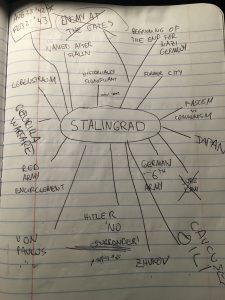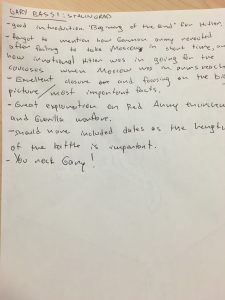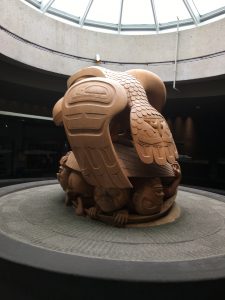https://www.youtube.com/watch?v=STIeOVMZe8k&feature=em-upload_owner
ENJOY <3
https://www.youtube.com/watch?v=STIeOVMZe8k&feature=em-upload_owner
ENJOY <3
Stalingrad Song/poem
All Along the Sniper Tower
There must be some kind of way out of hear
Said the sniper to the rat
There’s too much violence
I got cyanide under my hat
Hitler came he blew up my town
The blitz killed my friends
All I got is this AK-47
And the days never end
No reason to hope for tomorrow
The 6th army will fight to the end
Stalingrad is slowly burning
And there’s no sunlight coming around the bend
All I do is wait for a shot at the German solider
If I give up Kzukov will have me killed
I wish there was a way out of here
Too much blood has been spilled.
This 200 day battle has got me down
My comrades talk of victory
But it goes on and on
All we know is misery
We make a final push
The 6the army is encircled
This is a massive ambush
So I guess we win?
What was the point?
This battle has got me addicted to gin.

I used this learning map to teach Gary about the Battle of Stalingrad. My notes of his teaching to the group is below.


I took this picture because it was the most visually striking sculpture in the museum. While I am certainly not an expert on art, I found the detail of the carving to be amazing. Having spent time in Barcelona, where Gaudi is king, I became somewhat familiar with the avante guarde. While this sculpture is half a world away from Gaudi, the artists ability to create a life cycle of indigenous society is very valuable, as it shows people beneath nature. In my interpretation this is symbolic of indigenous peoples respect for nature and their surroundings.
There is a chance that I am totally misinterpreting this, but regardless of my interpretation, the sculpture is incredible.
To be or to be …
To be or to be – that is the question
Yes, you heard me right, to be or to be
Is the question. I’m in a sea of troubles
In my mind I suffer. To be is the verb
We use the most in English or Spanish.
Not to die or to sleep. Every time I say
Am, is, are, were, I am using “to be”.
But in Spanish, they have two different to be’s
Ser and Estar, which one do I need to use?
To say “I am”, it’s either soy or estoy
So here are 3 rules to help you decide:
First, when something’s permanent, you use “ser”
Description, nationality, profession
Are permanent traits, so then use ser
Soy canadiense, I am Canadian
Soy profesora, I am a teacher
Soy una mujer, I am a woman
Second, when something is temporary, it’s estar
Cómo estás? Estoy bien o contenta
How are you? I am well or happy
Third, if you’re talking about location
Then you will always want to use “estar”
Estoy en Vancouver, I’m in Vancouver
Estoy en el mercado, I’m at the market
But it gets complicated, in some cases
You can use both, but with different meaning
If I say soy feliz, I’m a happy person
But estoy feliz means I’m happy right now
Es lista, she is smart; esta lista, she’s ready
And if you’re totally confused, don’t take your life
Just use “ser”, it’s used more often than estar.
Language Assessment Across the Curriculum
We are group #6, the last reading group. We were also the largest group so thanks for your patience in our somewhat long winded projects and discussions.
As was noted in the reading; ‘Multi-literacies pedagogies seek to recognize and connect the language modes of speaking, writing, representing, listening, reading, and viewing. Teachers invite children to use their home/community languages and literacies as resources for classroom learning, positioning children as creators and researchers of language, helping them to become more aware of the role that language plays in social processes, and guiding all children to access languages and power and school literacies.’
Surrounding many of the key themes were the four perspectives of:
Socio-political perspective
Sociocultural perspective
Psycholinguistic perspective
Cognitive-psychological perspective
Our presenters worked hard on these multi-literacies, multimedia and digital literacy descriptions and/or understandings.
Kyle, Sylvie, Anna-Maria, Micheal, Brad, Garry, Dave and Kenny
A horror story told through image, music, and drama. Psychological thriller set in a remote town in the pacific north west. blood, bears, blundstones. Two student teachers face their final test. Will they follow their instincts, or play with fire? How will they be assessed?
Link for Prezi for Reading Group Two’s Presentation:
http://prezi.com/8o0b4fo0panj/?utm_campaign=share&utm_medium=copy
Shit TCs Say (2016)
To have fun, document our experiences, and invoke memories as a Teacher candidate in this program; through the usage of visual (video), auditory (lines, background music), kinesthetic (acting) mode of representation, with hint (lot) of humour. Humour is what makes information memorable, and is universal.
Jon Lam, John Lim, Emily Jang, Nikky Verma, Scott Kanou
Our group wants to create a parody of a late night informative talk show about the new curriculum. The show will include interview segments from a young new teacher contrasted by an old more experienced teacher. Both teachers will share their fresh ideas and questions about the new curriculum. In addition, the talk show will showcase an insight into Aboriginal Education. Lastly, a special appearance will be made by admin to offer guidance in implementing the new curriculum.
Alysha, Jillian, Michael, Taylor, Christine, Matt